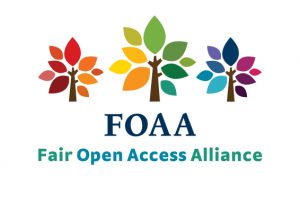The Fair Open Access Principles
- The journal has a transparent ownership structure, and is controlled by and responsive to the scholarly community.
- Authors of articles in the journal retain copyright.
- All articles are published open access and an explicit open access licence is used.
- Submission and publication is not conditional in any way on the payment of a fee from the author or their employing institution, or on membership of an institution or society.
- Any fees paid on behalf of the journal to publishers are low, transparent, and in proportion to the work carried out.
Clarification notes
- This could be ownership by an editorial board, or by a democratically controlled scholarly society, for example. Key points are that the controlling organization, not a commercial publisher, must own the journal title, so that a change of service provider can be achieved without changing the title, and so publishing companies simply compete to offer services to the journal. We strongly recommend that the ownership structure allow for democratic input by the community of readers, authors and referees, in addition to editors, and that procedures for making key decisions about the journal’s future be formally (even legally) specified. We strongly recommend that the governing organization be fully nonprofit (for example, IRS 501 (c) (3) in USA). A for-profit company accountable only to shareholders is not compatible with Principle 1.
- The journals and their publishing house can still propose, among their services, to take care of possible legal issues pertaining to copyright on the author’s behalf, under the author’s oversight. We strongly recommend that reviewers also retain copyright of their reviews, and journals retain ownership of all correspondence and mailing lists compiled on the electronic submission system put at their disposal by the publisher.
- Any form of subscription paywall is unacceptable, including “hybrid OA”. We strongly recommend that the industry standard CC-By licence be used. All content of the journal should be easily accessible from the journal website to anyone with a standard internet connection.
- The key idea is that journals be “free at the point of use” by authors and readers. Principle 3 deals with readers and Principle 4 with authors. Compulsory APCs (article publication charges) are not compatible with this principle. Journals should ideally be funded by general contributions from universities and research funders, with these contributions not tied to individual articles or groups of authors. Principle 4 is not compatible with “APC Big Deals”, whereby institutions pay for APCs of their employees but do not contribute to a general fund. Also not compatible is the practice of charging APCs by default to the author’s institution, with waivers for authors who do not have institutional funds. The principle does not preclude voluntary APCs, but requests for these must be unobtrusive and no barrier to publication. APCs must be “opt-in”, never “opt-out”.
- “Low” depends on the particulars of each journal and on the discipline, but we strongly recommend that fees be no more than $50 per page, and definitely no more than $1000 per article published. Substantially lower fees should be possible in many cases.
